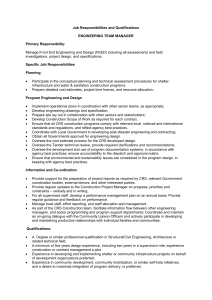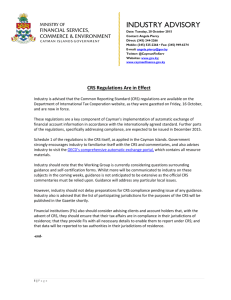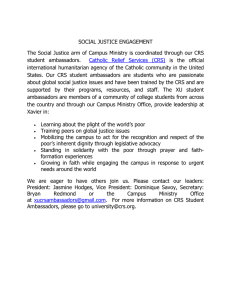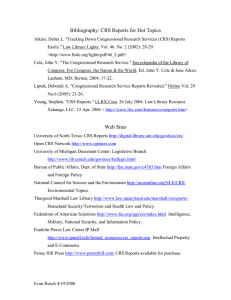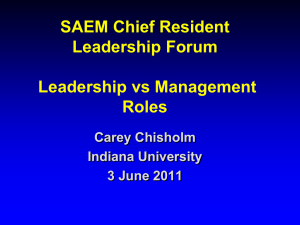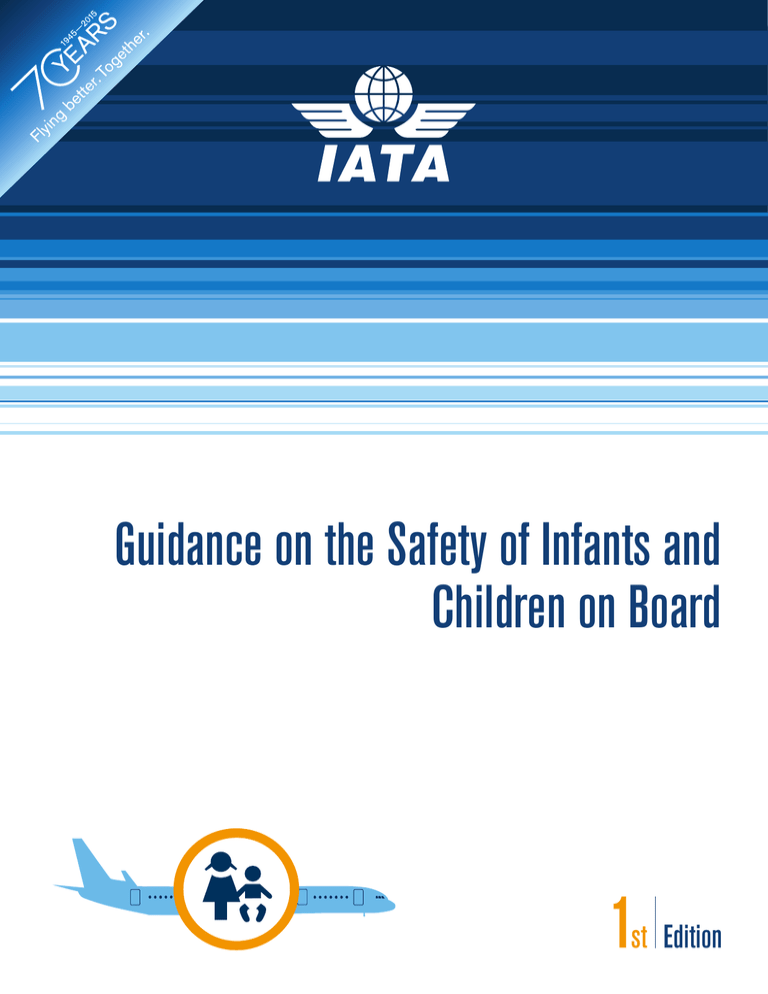
Guidance on the Safety of Infants and
Children on Board
1st Edition
NOTICE
DISCLAIMER. The information contained in this
publication is subject to constant review in the light
of changing government requirements and regulations. No subscriber or other reader should act on
the basis of any such information without referring
to applicable laws and regulations and/or without
taking appropriate professional advice. Although
every effort has been made to ensure accuracy, the
International Air Transport Association shall not be
held responsible for any loss or damage caused by
errors, omissions, misprints or misinterpretation of
the contents hereof. Furthermore, the International
Air Transport Association expressly disclaims any
and all liability to any person or entity, whether a
purchaser of this publication or not, in respect of
anything done or omitted, and the consequences
of anything done or omitted, by any such person or
entity in reliance on the contents of this publication.
© International Air Transport Association. All
Rights Reserved. No part of this publication may
be reproduced, recast, reformatted or transmitted in any form by any means, electronic or
mechanical, including photocopying, recording or any information storage and retrieval system, without the prior written permission from:
Senior Vice President
Safety and Flight Operations
International Air Transport Association
800 Place Victoria
P.O. Box 113
Montreal, Quebec
CANADA H4Z 1M1
Guidance on the Safety of Infants and Children on Board
ISBN 978-92-9252-697-9
© 2015 International Air Transport Association. All rights reserved.
Montreal—Geneva
TABLE OF CONTENTS
INTRODUCTION ..................................................................................................................................................... 1
1.
PURPOSE OF THIS GUIDANCE ................................................................................................................ 2
1.1
2.
IATA OPERATIONAL SAFETY AUDIT (IOSA) ..................................................................................... 3
RECOMMENDATION OF USE OF CRS ..................................................................................................... 4
2.1
2.2
INFANT ..................................................................................................................................... 4
CHILD ....................................................................................................................................... 4
3.
OPERATIONAL CONSIDERATIONS: POLICIES AND PROCEDURES ............................................................ 5
4.
OPERATIONS WITH AN APPROVED PASSENGER-PROVIDED CRS ........................................................... 6
5.
INSTALLATION OF CRS ON BOARD ........................................................................................................ 7
6.
OPERATIONS WITH OPERATOR-PROVIDED CRS .................................................................................... 8
7.
PLACEMENT OF CRS ON BOARD ............................................................................................................ 9
8.
WORKING WITH THE REGULATOR....................................................................................................... 10
9.
INFORMATION TO PASSENGERS REGARDING CRS COMPATIBILITY ..................................................... 11
9.1
9.2
9.3
9.4
9.5
9.6
10.
OTHER DEVICES THAT PROMOTE CHILD PASSENGER SAFETY .............................................................. 17
10.1
10.2
10.3
11.
SAMPLE OF LABELS .................................................................................................................... 12
SAMPLE LABEL DEPICTING A DEVICE OR CRS NOT MEETING OPERATIONAL REQUIREMENTS....................... 14
SAMPLE PICTORIALS ................................................................................................................... 15
CRS REQUIRING A 3-POINT HARNESS ............................................................................................ 15
CRS REQUIRING A 2-POINT HARNESS ............................................................................................ 15
CRS THAT CAN BE SECURED IN THE AFT AND FORWARD FACING POSITION WITH A 2-POINT HARNESS .......... 16
AVIATION SAFETY HARNESS FOR CHILDREN .................................................................................... 17
INFANT CRADLE SYSTEM (CERTIFIED FOR DURING TURBULENCE) ........................................................ 17
TRAVEL CHAIRS FOR CHILDREN WITH REDUCED MOBILITY ................................................................. 18
EVACUATIONS WITH INFANTS AND CHILDREN .................................................................................... 19
Safety of Infants and Children on Board
Page i
May 2015
INTRODUCTION
IATA plays a key role in raising awareness of important cabin safety issues. Cabin safety is a
component of an airline safety management system that includes proactive data collection and
the ensuing prevention activities related to cabin design and operation, equipment, procedures,
crew training, human performance, and passenger management. Cabin safety also comprises of all
activities that cabin crew must accomplish in order to contribute to the safe and efficient
operation of the aircraft during normal, abnormal and emergency situations.
These guidelines are the product of work carried out by the IATA Cabin Operations Safety Task
Force (COSTF) which is comprised of safety experts from IATA member airlines. The COSTF is
established to develop, promote and improve standards, procedures and best practices to ensure
safety and security in all aspects of cabin operations. The representatives are experts in the
domain of Cabin Safety, Cabin Crew Training, Incident and Accident Investigation, Human Factors
and Quality Assurance. IATA wishes to thank the IATA Cabin Operations Safety Task Force for their
dedication and hard work.
These guidelines are not intended to replace or contradict any current State regulations nor the
IOSA Standards and Recommended Practices (ISARPs). Airlines should always comply with the
regulations and requirements of their competent Authority. We welcome your feedback and
contributions. Please forward your suggestions or comments to cabin_safety@iata.org. To view
other guidance documents, visit: www.iata.org/cabin-safety.
Safety of Infants and Children on Board
Page 1
May 2015
1.
PURPOSE OF THIS GUIDANCE
IATA recognizes that the safest way to secure an infant or child on board an aircraft is in an
approved child restraint system. It is for this reason that IATA recommends the use of an approved
child restraint system (CRS) for travel and encourages airlines to promote their use on board. IATA
has drafted the following guidelines to encourage and promote the use of a CRS on board aircraft
when they are accepted by the State.
The current lack of harmonized State regulations specific to child restraints systems interferes
with the seamless use of passenger provided CRS. As certain States do not accept foreign
approved CRS, passengers are sometimes not permitted to use their CRS when travelling on a
foreign airline. Although their CRS is approved in their State, they are instructed to lap hold their
infant (with or without a supplemental loop belt, depending on the airline’s State regulatory
requirement) or to place their child in a seat secured with a lap belt while their CRS is placed in the
hold of the aircraft.
A harmonized solution that enables and safely promotes the use of CRS for travel on board aircraft
globally is required. IATA recommends that an internationally recognized solution be sought on
the issue of child restraints and is committed to working with the International Civil Aviation
Organization (ICAO) to achieve this. The responsible identification of a solution should be based
on a strong data foundation and supported by a well-documented safety risk analysis. The
comprehensive solution should be applicable worldwide and be practical, affordable,
operationally realistic, feasible and harmonized. However, this harmonized solution is a complex
one that could take some time to achieve as the regulators assess their current regulatory
requirements and harmonize their regulations.
As a first priority, IATA urges regulators to accept foreign approved child restraint systems so that
airlines can accept the use of passenger-provided foreign approved CRS on board their aircraft.
IATA cautions on any regulatory change at the individual State level that would mandate the use
of a specific child restraint system as there is no international Standard addressing this at this
time.
IATA has developed the Guidance on the Safety of Infants and Children on Board with the aim of
further encouraging and promoting the use of approved CRS on board aircraft by creating
heightened awareness on this important topic with both industry at large and members of the
traveling public.
Safety of Infants and Children on Board
Page 2
May 2015
1.1
IATA Operational Safety Audit (IOSA)
The IATA Operational Safety Audit (IOSA) Program is an internationally recognized and accepted
evaluation system designed to assess the operational management and control systems of an
Operator. The safety and security requirements published in the Annexes to the Convention on
International Civil Aviation (ICAO Annexes) are the primary source for specifications contained in
the ISARPs.
As outlined in the IATA Operational Safety Audit (IOSA) Standards Manual (ISM), provisions and
guidelines that are applicable to the carriage of infants are drafted in order to promote a means to
restrain an infant as applicable to the airline authority’s regulations. In the absence of a State
regulation, the IOSA provisions require that an airline still develops procedures.1
CAB 3.4.5 If the Operator conducts passenger flights with or without cabin crew, the Operator
shall have procedures to ensure the secure restraint of infants during the phases of flight and
conditions specified in CAB 3.4.4. (GM)
Guidance
The term “infant” refers to small children as defined by the Authority. If the Authority does not
have a definition, the operator would publish its own definition in the OM. An “infant” is typically
defined as a child that is less than two years of age. Some regulatory authorities require the use of
child restraint devices, for which there is no universally accepted definition. The term “restraint
devices” refers to any device that is accepted by the Authority and is utilized specifically to keep
small children restrained in the aircraft cabin. Automobile seats approved for use on an aircraft,
“loop belts” and “infant seat belts” are examples of child restraint devices. Procedures would be in
place to ensure infants are securely restrained. Such procedures typically include the use of infant
restraint devices or could specify other means of restraint. If the Authority requires specific
procedures (e.g. infants held by an adult who is occupying an approved seat or berth) or identifies
an approved type of restraint device, the operator is required to be in compliance with those
requirements.
1
www.iata.org/iosa
Safety of Infants and Children on Board
Page 3
May 2015
2.
RECOMMENDATION OF USE OF CRS
The use of an approved child restraint system is the recommended means to secure an infant or
child on board an aircraft. It also provides for the person responsible for the infant or child to have
their CRS available for travel in an automobile upon arrival at their destination. For the purpose of
this document, a responsible person may be a parent, guardian or caregiver.
2.1
Infant
An infant (is less than 2 years of age) should be restrained in an approved child restraint system
which meets the product limitations (height and weight) as established by the CRS manufacturer.
If the responsible person does not provide an approved infant restraint
system, or if the CRS is not accepted in accordance with the airline
authority’s regulations, the infant should be held by a responsible person
with the seatbelt fastened around the responsible person for take-off,
landing, when the fasten seat belt sign is illuminated, and recommended at
all times while seated in case of unexpected turbulence.
Note: Currently, some States require a lap held infant to be additionally
restrained by a supplemental loop belt device. When a supplemental loop
belt is required, airline SOPs should require cabin crew to advise the
responsible person on how to use it, and the safest orientation for the
infant.
2.2
Child
A child (is 2 years of age or older) should also be restrained in an approved child restraint system
which meets the product limitations (height and weight) as established by the CRS manufacturer.
If the responsible person does not provide an approved child restraint system, or if the CRS is not
accepted in accordance with the airline authority’s regulations, and if the child is able to sit
upright unassisted, the child should be restrained by a seat belt for take-off, landing, when the
fasten seat belt sign is illuminated and recommended at all times
while seated in case of unexpected turbulence. Another
consideration for securing a child on board could be the use of a
passenger provided aviation safety harness. Please see Section 10.1
for more details.
Safety of Infants and Children on Board
Page 4
May 2015
3.
OPERATIONAL CONSIDERATIONS: POLICIES AND PROCEDURES
Not all regulators accept foreign approved child restraint systems. CRS acceptance is based on the
applicable State criteria and is reflected in the airline policy. Airlines should develop policies
related to the transportation of infants and children outlining the permitted use of a CRS on
board. It should also include prohibited devices which may not be used on board. It should also
include the types of approved CRS and their permitted use when on board their aircraft. Such
criteria should include provisions stating that the CRS must:
Only be occupied by an infant or child that meets the product limitations (height and
weight) of the CRS as established by the manufacturer;
Fit the aircraft seat dimensions; and
Not cause any obstruction of egress in an emergency when installed.
Cabin crew should be aware of their airline’s policy and procedures
surrounding the carriage of infants and children and the
acceptance or prohibition of CRS for use on board. In addition, it is
also important for ground staff (e.g. check-in and gate agents) to
be aware of the airline’s policy and procedures related to the
acceptance and prohibition of devices permitted for on board use.
The policy should mention restrictions, if any, of the amount of
infants (less than 2 years of age) a single responsible person may
travel with. Some States and/or airlines accept for a responsible person to have charge of only one
infant. Others accept for the responsible person to have charge of two infants when one infant is
restrained in a CRS and the other infant is lap held (with or without supplementary loop belt, as
applicable to State regulations). Possible mitigations for a responsible person traveling with two
infants is to provide a briefing to an Able-Bodied Person (ABP) who could assist the responsible
person with the infant in the event of an abnormal or emergency situation.
It is also recommended that the policy include information related to when a child travels in a
separate section of the aircraft than their responsible person. Some carriers implement
procedures for the handling of a child of UMNR age who is traveling in a separate section of the
aircraft. These procedures can include increased supervision and the handling of this child as an
UMNR while on board and in this separate class of service by the cabin crew.
Safety of Infants and Children on Board
Page 5
May 2015
4.
OPERATIONS WITH AN APPROVED PASSENGER-PROVIDED CRS
Airlines generally do not provide CRS for use by infants or children on board, with the exception of
the supplemental loop belt type device when their use is mandated by the State. The responsible
person is responsible for providing and installing their own CRS device for use on board the
aircraft. The following information should be conveyed to the responsible person of an infant or
child using a CRS:
Infants and children secured in a CRS should be seated with the responsible person;
Infant(s) and child(ren) must be secured in the CRS during taxi, take-off, landing,
whenever the seat belt sign is illuminated, and recommended at all times when seated in
case of unexpected turbulence.
Safety of Infants and Children on Board
Page 6
May 2015
5.
INSTALLATION OF CRS ON BOARD
All devices must be installed in accordance with the manufacturer instructions of the CRS. They
must also be secured using the aircraft seat belts that are fixed to the seat. The CRS should be
correctly installed and secured by the occupant’s responsible person as they are most acquainted
with the CRS and the applicable manufacturer’s instructions.
Cabin crew procedures should include:
Verifying if the CRS is approved for on board use;
Applying seat allocation restrictions (if any);
Conducting a visual check.
Some airline procedures include the cabin crew requesting for a verbal confirmation
from the responsible person that they have correctly installed and secured the device.
Other airlines ask the responsible person to advise the cabin crew if they are not able to
install or secure the device.
Installation of aft-facing CRS: Aft-facing CRSs should only be installed on forward-facing
passenger seats. Aft-facing child restraint devices are usually restricted to an occupant
(and usually to only an infant) weighing less than 20 pounds.
Installation of forward-facing CRS: Forward-facing CRSs may only when fitted in the
same direction as the passenger seat.2 These devices are usually recommended for an
infant or child weighing 20 to 65 pounds. Some forward-facing devices may
accommodate children of a greater weight when this is specified on the device itself.
Note:
It is imperative for all CRS to be installed as per the manufacturer's
instructions;
A CRS should not be installed within the radius of action of an airbag unless
the airbag is de-activated with a seatbelt deactivator.
2
https://www.easa.europa.eu/system/files/dfu/Consolidated%20%28unofficial%29%20AMC%26GM%20to
%20Annex%20IV%20%28Part-CAT%29.pdf
Safety of Infants and Children on Board
Page 7
May 2015
6.
OPERATIONS WITH OPERATOR-PROVIDED CRS
Some airlines provide CRS for infants or children. When the CRS is provided by the airline for use
on board their aircraft, the cabin crew are usually responsible for installing the CRS device. The
same information as stated in section 4 and section 5 (as applicable the context of an operator
provided CRS) should be conveyed.
This would include:
Infants and children secured in a CRS should be seated beside the responsible person;
Infant(s) and child(ren) must be secured in the CRS during taxi, take-off, landing,
whenever the seat belt sign is illuminated, and recommended at all times when seated in
case of unexpected turbulence.
The cabin crew should also conduct a visual check to ensure the CRS is installed correctly prior to
departure.
Safety of Infants and Children on Board
Page 8
May 2015
7.
PLACEMENT OF CRS ON BOARD
Airline procedures should contain information on the placement of the CRS on board. This should
address whether the use of a CRS is permitted or prohibited on unique design seats (e.g. angled or
aft facing seats). The procedures should also include where the placement of a CRS is not
permitted, for example:
In an emergency exit row;
In a row immediately forward or aft of an emergency exit row (if this is stipulated as per
State regulations);
On a seat fitted with an inflatable seat belt (unless permitted when deactivated with the
manufacturer’s seat belt deactivator);
In a location that could:
o
Prevent access to safety and emergency equipment; and/or
o
Block access to an aisle of the aircraft.
The procedures should also include the recommended location for the CRS, for example:
A window seat is preferred location; or
In an inner seat of a center row on dual aisle aircraft, the CRS may be placed in the
center section provided that all persons in the row have unobstructed access to an aisle;
and
With the responsible person accompanying the infant or child occupying the CRS.
Safety of Infants and Children on Board
Page 9
May 2015
8.
WORKING WITH THE REGULATOR
Airlines are encouraged to work with their regulator in instances when a specific CRS is certified
for air travel but is not yet recognized or approved for use by their State. An equivalent level of
safety (ELoS) assessment can also be submitted by the airline to review, in cooperation with their
regulator, a passenger’s request to use a specific device on board.
This cooperation and information gathering could potentially lead to a regulatory change and/or
exemption for the approval of use of a specific CRS or for a particular situation (e.g. a child
passenger with reduced mobility).
The airline would normally conduct a risk assessment to assess the impact, if any, of the
acceptance or refusal of a new type of CRS in its operations. The airline would also provide the
State with information on how they would mitigate any safety concerns and meet any condition of
use as stipulated by their regulator. This cooperation between the airline and State promotes child
passenger safety and recognizes that an infant or child is safer when secured with a certified CRS
rather than a carrier having to prohibit its use on board, on account of a specific, absent or an
outdated regulation.
Safety of Infants and Children on Board
Page 10
May 2015
9.
INFORMATION TO PASSENGERS REGARDING CRS COMPATIBILITY
Information to members of the travelling public is important in promoting the use or CRS on board
aircraft. The United States Federal Aviation Administration (FAA) has developed a website
dedicated to members of the travelling public to promote awareness and the use of a CRS on
board aircraft: www.faa.gov/passengers/fly_children.
IATA calls for other regulatory authorities to consider following this example in order to provide
for this same type of awareness and promotion of child passenger safety on board aircraft in their
respective States.
Airlines are encouraged to share their policies on child restraint systems on their websites, via
social media, inflight magazines etc. By providing advanced information to passengers, it serves to
encourage the use of a CRS on board their aircraft. Providing passengers with information about
the acceptance, permission of use and compatibility of a CRS prior to their flight also allows the
responsible person to make an informed decision so they can best prepare and equip themselves
with an approved CRS prior to travel.
Not all motor vehicle CRS are suitable for use on board. Certain CRS are quite large and may not fit
into all aircraft seats. Passengers should be aware of certain aspects to take into account when
considering whether a CRS is compatible for travel on board:
Aircraft seat size (e.g. possibility of lack of space);
Inability to effectively restrain the CRS (e.g. 3-point CRS which requires a shoulder
harness, not suitable for an aircraft seat equipped only with a lap belt);
When not suitable for use in specific seat types (e.g. angled seats).
Such information should be available to passengers pre-flight and be easily accessible and
referenced, such as on the airline website, so that the traveler can determine the compatibility of
their CRS with the aircraft seat and aircraft type. This information should also include:
A list of accepted types of CRS;
A list of prohibited types of CRS;
The width of the passenger seat in each class of service for each model and series of
aircraft in its fleet, with a disclaimer that aircraft substitutes can occur during irregular or
normal operations.
Safety of Infants and Children on Board
Page 11
May 2015
It is important that this information be tailored to be comprehensible and practical to a passenger.
Copy-pasting information from the airline operations manual, which is intended and written for
airline employees and crewmembers, is not recommended as the information would be delivered
in a more technical format.
It would also be important to convey to a passenger that:
9.1
They will be asked to show the approval labelling to ground staff and cabin crew and to
make sure they know where to find it.
They may need to show the cabin crew that they have fitted the CRS securely and in
accordance with the manufacturer’s instructions; and
That the CRS must fit securely using a normal aircraft seatbelt, as unlike in automobiles,
the aircraft seat does not provide an ISOFIX systems or seatbelts that are worn over the
shoulder (unless shoulder seatbelts are provided in premium class seats (non-angled
seats);
If a passenger is not using a CRS for a child in an angled seat, it is recommended to advise
them that the recommended seating for the child is directly next and in front of the
responsible person so that can see them.
Sample of labels
Airlines are encouraged to include samples of labels of accepted CRS in both their operations
manual (OM) and on their external airline website. This will enable front line staff to validate the
acceptance of the child restraint device. In addition, this information, when provided in advance,
enables responsible person to make informed decisions on what child restraint system will be
accepted for use on board. The labels should be legible and clear. These often include language
such as:
“This restraint is certified for use in motor vehicles and aircraft”; or
“Approved for aircraft use only”.
It is recommended that a notation for passengers intending to travel with an infant or child to
check with the airline prior to booking a flight, especially when a trip involves multiple flight
segments on other airlines, as not all airlines are regulated with the same criteria of acceptance of
CRS on board.
Safety of Infants and Children on Board
Page 12
May 2015
Some sample labels include:
Australian/New Zealand Approved Labelling
EU Approved Labelling:
Approved for use in motor vehicles
according to the UN standard “ECE R
44, -03” or later
‘Qualification Procedure for Child
Restraint Systems for Use in Aircraft’
(TÜV Doc.: TÜV/958-01/2001)
FAA Approved Labelling
Canadian Approved Labelling
Approved for use in motor vehicles and aircraft Standard CMVSS 213/213.1
according to US FMVSS No. 213
Safety of Infants and Children on Board
Page 13
May 2015
9.2
Sample label depicting a Device or CRS not meeting operational
requirements
Should an airline prohibit the use of certain devices or types of CRS, they should identify the types
of devices or CRS in the operations manual for cabin crew awareness. The airline should also
provide passengers with this information prior to their flight so responsible person can make an
informed decision on and which types of devices or CRS are approved for use on board.
Examples of prohibited devices or types of CRS could include:
Booster seats;
Any vests and or sling type device;
A CRS which is only certified for use with a 3-point harness seat belt
(shoulder strap), as most of the aircraft cabin seats are certified with a 2point harness seat belt. This type of CRS may not be accepted for use on
board or may only be permitted in classes of service with seats that are
equipped with a 3-point harness (shoulder strap).
Please see extract below, detailing manufacturer “Warning information”.
Safety of Infants and Children on Board
Page 14
May 2015
9.3
Sample pictorials
Specified diagrams should be included to facilitate understanding when an airline accepts CRS
with:
9.4
3-point harness only; or
2-point harness only, or
Both (as applicable to the aircraft seat designs in the respective aircraft cabins)
CRS requiring a 3-point harness
Some airlines may have seats equipped with a 3-point harness installed. These are usually seen in
premium class seats. Where such a belt is installed, the CRS depicted below would meet the
manufacturer’s installation requirement and therefore would be suitable for use on board.
9.5
CRS requiring a 2-point harness
An example of an aft facing CRS that may be used on board and is to be secured with a 2-point
harness:
Safety of Infants and Children on Board
Page 15
May 2015
9.6
CRS that can be secured in the aft and forward facing position
with a 2-point harness
Safety of Infants and Children on Board
Page 16
May 2015
10.
OTHER DEVICES THAT PROMOTE CHILD PASSENGER SAFETY
IATA does not promote any specific product or brand but rather seeks to raise awareness on some
additional devices that are available and approved by some regulatory authorities for use on
board aircraft. IATA encourages States to allow airlines to accept these on board.
10.1
Aviation Safety Harness for Children
If the State permits airlines to accept the use of a passenger provided aviation safety harness, it is
recommended that the airline also include information and pictorials related to their acceptance
and approval of use on board. This should include a notation that these must be installed and used
according to the manufacturer’s instructions and/or a link to the supplier’s webpage for ease of
access to this information. Some supplier’s provide installation videos and it can be recommended
by the airline or State for the responsible person to view video instructions prior to their travel as
they will be responsible for installing the device and ensuring their child is secure.
10.2
Infant Cradle System (Certified for During Turbulence)
Infant cradle systems are commercially available to airlines and are
designed and certified for use during turbulence provided that the
safety features (e.g. belts) are used according to the manufacturer’s
instructions. These cradles are designed for infants up to a defined
weight. It is recommended that the responsible person is able to
reach the cradle with their own seatbelt fastened.
The cradle can be mounted on a bulkhead and it is certified for use
during turbulence, reducing the need to disturb and remove the
infant. This is especially useful during unexpected turbulence when
it could be difficult, challenging or riskier to remove the infant. In cases of expected turbulence,
especially for turbulence levels exceeding light turbulence, the safest place to secure an infant is in
their CRS.
Safety of Infants and Children on Board
Page 17
May 2015
10.3
Travel Chairs for Children with Reduced Mobility
Airlines are encouraged to provide information for the responsible person requiring special
assistance for travel with a child with reduced mobility.
There are a variety of comfort and support seating aids permitted to be used if the State permits,
provided the use of the aircraft seatbelt remains part of the restraint system. If secured with a
strap around the upper part of the seat, the seat behind should remain unoccupied unless seat
certification and testing shows that Head Injury Criterion (HIC) regulations can be complied with.
Examples include Travel Chairs which provide postural support for disabled children who may
otherwise be unable to travel by air.
If the State permits airlines to accept use of specific airline and/or passenger approved travel
chairs, it is recommended that the airline also include information and pictorials related to their
acceptance, location and approval for use on board. This should include a notation that these
travel chairs must be installed and used according to the manufacturer’s and airline’s instructions.
The UK CAA has determined that an aircraft operator may accept its use under the future
provisions of the EASA Air Operations Regulation, CAT.OP.MPA.225. For more information, please
go to: www.caa.co.uk/docs/33/SafetyNotice2012015.pdf
Safety of Infants and Children on Board
Page 18
May 2015
11.
EVACUATIONS WITH INFANTS AND CHILDREN3
Airlines should have procedures for cabin crew that are specific to the evacuation of infants and
children. The responsible person should be made aware to remove the infant or child from the
CRS for the evacuation process and to always leave the CRS behind.
In a planned emergency evacuation, the responsible person should be briefed to hug their infant
to them so that they can evacuate down the slide together. When boarding an escape device (e.g.
slide, slide raft, ramp slide) with infants, jumping together onto the escape device produces faster
egress than sitting and sliding.
The carrying positions that provide the most protection for infants include:
Vertical position: The responsible person should protect the infant’s head and neck as
much as possible with one hand, placing the other arm around the buttocks and holding
the infant with their legs around the adult’s waist;
Horizontal position: The responsible person should cradle the infant’s head and neck in
their arm and should keep infant’s arms, legs and feet enfolded as much as possible in
their arms.
Climbing through a Type III over-wing exit while holding an infant promotes faster egress than
passing the infant to another passenger who has already exited. The recommended carrying
position of the infant is vertical. Horizontal carrying of larger infants is more likely to result in
striking a part of the infant’s body on the exit frame.
Evacuation methods with children over the age of two would depend on the age and size of the
child. The carrying method when egressing should be the one most comfortable and natural for
the parent/responsible person and the child and, at the same time, providing adequate protection
for the child and ensuring a fast egress from the aircraft.
3
EASA, Safety Information Bulletin (SIB), No.: 2013-06, Issued: 17 May 2013, Evacuation of Infants
Safety of Infants and Children on Board
Page 19
May 2015

